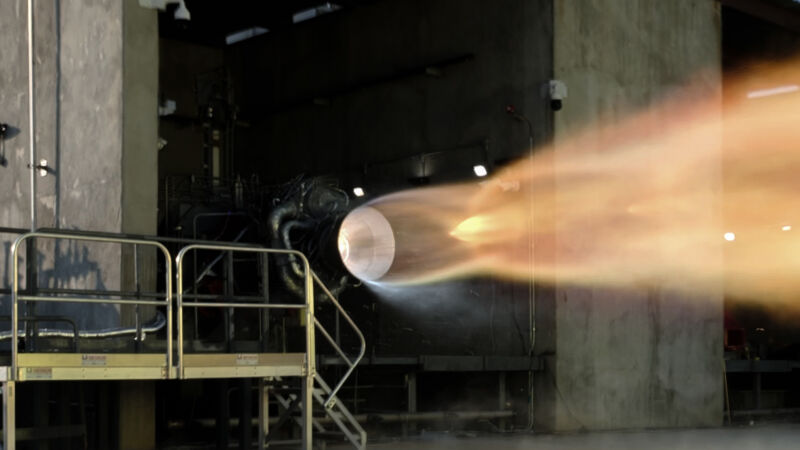All the news that’s fit to lift —
“Coming soon: a full recovery rehearsal with our landing vessel.”

Enlarge / Rocket Lab says it fired up the Archimedes engine at full thrust this week.
Rocket Lab
Welcome to Edition 7.06 of the Rocket Report! There has been a lot of drama over the last week involving NASA, the crew of Starliner on board the International Space Station, and the launch of the Crew-9 mission on a Falcon 9 rocket. NASA is now down to a binary choice: Fly Butch Wilmore and Suni Williams home on Starliner, or send two astronauts to orbit on Crew-9, and return Wilmore and Williams next February on that spacecraft. We should know NASA’s final decision next week.
As always, we welcome reader submissions, and if you don’t want to miss an issue, please subscribe using the box below (the form will not appear on AMP-enabled versions of the site). Each report will include information on small-, medium-, and heavy-lift rockets as well as a quick look ahead at the next three launches on the calendar.

Firefly inks another big Alpha contract. Firefly Aerospace said Wednesday that it has signed a multi-launch agreement with L3Harris Technologies for up to 20 launches on Firefly’s Alpha rocket, including two to four missions per year from 2027 to 2031, depending on customer needs. The new agreement is in addition to Firefly’s existing multi-launch agreement with L3Harris for three Alpha missions in 2026. What is not clear is exactly what satellites L3Harris wants to launch.
Putting skins on the wall … “Firefly continues to see growing demand for Alpha’s responsive small-lift services, and we’re committed to providing a dedicated launch option that takes our customers directly to their preferred orbits,” said Peter Schumacher, Interim CEO at Firefly Aerospace. This represents another significant win for the Alpha rocket, which can lift about 1 metric ton to low-Earth orbit. Under terms of a separate agreement announced in June, Lockheed purchased 15 launches from Firefly, with an option for 10 more, through the year 2029. (submitted by Ken the Bin and EllPeaTea)
Electron pushing launch cadence. Rocket Lab announced Wednesday that it has scheduled the launch for its 52nd Electron mission, which will deploy a single satellite for American space tech company Capella Space. The mission is scheduled to launch during a 14-day window that opens on August 11 from Rocket Lab Launch Complex 1 on New Zealand’s Mahia Peninsula.
Getting to ten much faster … Should this launch take place at the opening of this window, this Electron flight would occur just eight days after the most recent Electron mission on August 3. This upcoming mission for Capella will be Rocket Lab’s tenth mission for 2024, equaling the company’s annual launch record set in 2023. (submitted by Ken the Bin)
The easiest way to keep up with Eric Berger’s space reporting is to sign up for his newsletter, we’ll collect his stories in your inbox.
PLD Space to start work on launch site. PLD Space plans to start building launch facilities for its Miura 5 rocket in October from the Diamant site at Guiana Space Centre, cofounder and Chief Business Development Officer Raúl Verdú said this week, Space News reports. Diamant has been dormant for decades after once being used for the French rocket of the same name, and “in the area where we are there is nothing,” Verdú said, “we have to do everything from scratch.”
Lots of things to build … PLD Space, Germany’s Isar Aerospace and a handful of other small European launchers are working with France’s CNES space agency to convert the site into a multi-use facility. In June, the Spanish company announced a 10 million euro ($11 million) investment plan for 15,765 square meters of space at Diamant, divided between a launch zone and a preparation area comprising an integration hangar, clean room, control center, commercial and work offices. CNES is providing common infrastructure such as roads and electricity networks. (submitted by Ken the Bin)
Japanese firm raises $21 million. Interstellar Technologies announced a new fundraising round that brings its total capital and government funding to $117 million, Payload reports. After building and launching a suborbital rocket called Momo, the company is building its first orbital rocket, dubbed ZERO, with a goal of flying in 2025. This rocket is intended to carry 800 kg of payload to low-Earth orbit, and be cheaper than Rocket Lab’s Electron, COO Keiji Atsuta said.
Big help from Japan … Interstellar’s latest round was led by Japanese VC fund SBI and NTT Docomo, the country’s leading mobile firm. Previously, it received a large amount of funding, $96 million, from the Japanese government. “The Japanese government has explicitly expressed its support for private rockets due to the growing importance of the space industry, and being selected for this support program has significantly accelerated our business,” Interstellar CEO Takahiro Inagawa said. (submitted by Ken the Bin)
Cross-border deal benefits Nova Scotia spaceport. The Canadian government says it has completed negotiations with the United States on an agreement that would allow the use of US space launch technology, expertise, and data for space launches in Canada, the AP reports. Maritime Launch Services, the company developing Canada’s first commercial spaceport in northeastern Nova Scotia, called the agreement a major step forward for the industry.
US rockets could launch from Canada … Ottawa has said it hopes to position Canada as future leader in commercial space launches. The country has geographical advantages, including a vast, sparsely populated territory and high-inclination orbits. The agreement, which is yet to be signed, will establish the legal and technical safeguards needed while ensuring the proper handling of sensitive technology, the government said in a news release. (submitted by JoeyS-IVB)